Human head
| Human head | |
|---|---|
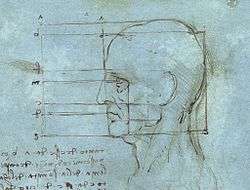 The human head drawn by Leonardo da Vinci | |
| Details | |
| Identifiers | |
| Latin | caput |
| MeSH | D006257 |
| TA | A01.1.00.001 |
| FMA | 7154 |
| Anatomical terminology | |
In human anatomy, the head is the upper portion of the human body. It supports the face and is maintained by the skull, which itself encloses the brain.
Structure
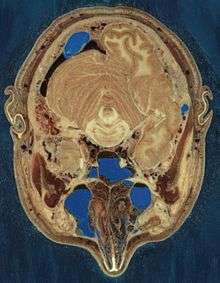
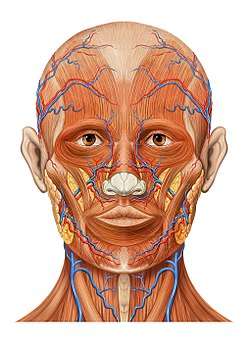
The human head consists of a fleshy outer portion surrounding the bony skull, within which sits the brain. The head rests on the neck, and is provided bony support for movement by the seven cervical vertebrae.
The face is the anterior part of the head, containing the sensory organs the eyes, nose and mouth. The cheeks, on either side of the mouth, provide a fleshy border to the oral cavity. To either side of the head sit the ears.
Blood supply
The head receives blood supply through the internal and external carotid arteries. These supply the area outside the skull (external carotid artery) and inside of the skull (internal carotid artery). The area inside the skull also receives blood supply from the vertebral arteries, which travel up through the cervical vertebrae.
Nerve supply
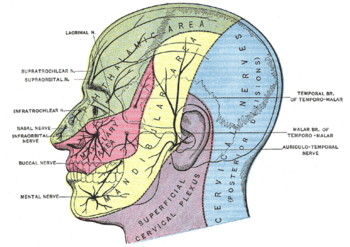
The twelve pairs of cranial nerves provide the majority of nervous control to the head. The sensation to the face is provided by the branches of the trigeminal nerve, a cranial nerve. The sensation to other portions of the head is provided by the cervical nerves.
Modern texts are in agreement about which areas of the skin are served by which nerves, but there are minor variations in some of the details. The borders designated by the diagrams in the 1918 edition of Gray's Anatomy, provided below, are similar but not identical to those generally accepted today.
The cutaneous innervation of the head is as follows:
- Ophthalmic nerve (green)
- Maxillary nerve (pink)
- Mandibular nerve (yellow)
- Cervical plexus (purple)
- Dorsal rami of cervical nerves (blue)
Function
The head contains sensory organs: two eyes, two ears, a nose and inside the mouth a tongue. It also houses the brain.
Society and culture
For humans, the head and particularly the face are the main distinguishing feature between different people, due to their easily discernible features such as hair and eye color, nose, eye and mouth shapes and wrinkles. The human head typically weighs between 5 and 11 pounds (2.3 and 5.0 kg). Human faces are easily differentiable to us due to our brains' predispositions toward discriminating human facial forms. When observing a relatively unfamiliar species, all faces seem nearly identical, and human infants are biologically programmed to recognize subtle differences in anthropic facial features.
People who are more intelligent than normal are sometimes depicted in cartoons as having bigger heads, as a way of notionally indicating that they have a "larger brain"; in science fiction, an extraterrestrial having a big head is often symbolic of high intelligence. Outside this symbolic depiction, however, advances in neurobiology have shown that the functional diversity of the brain means that a difference in overall brain size is only slighty to moderately correlated to differences in overall intelligence between two humans.[1]
The head is a source for many metaphors and metonymies in human language, including referring to things typically near the human head ( "the head of the bed"), things physically similar to the way a head is arranged spatially to a body ("the head of the table"), metaphorically ("the head of the class/FBI") and things that represent some characteristic we associate with the head, such as intelligence ("there are a lot of good heads in this company").[2]
Ancient Greeks had a method for evaluating sexual attractiveness based on the Golden ratio, part of which included measurements of the head.
Clothing
.jpg)
In many cultures, covering the head is seen as a sign of respect. Often, some or all of the head must be covered and veiled when entering holy places, or places of prayer. For many centuries, women in Europe, the Middle East, and South Asia have covered their hair as a sign of modesty. This trend has changed drastically in Europe in the 20th century, although is still observed in other parts of the world. In addition, a number of religious paths require men to wear specific head clothing—such as the Islamic Taqiyah_(cap), Jewish yarmulke, or the Sikh turban; or Muslim women, who cover their hair, ears, and neck with a scarf.
People may cover the head for other reasons. A hat is a piece of clothing covering just the top of the head. This may be part of a uniform, such as a police uniform, a protective device such as a hard hat, a covering for warmth, or a fashion accessory.
Different headpieces can also signify status, origin, religious/spiritual beliefs, social grouping, team affiliation, occupation, or fashion choices.
Anthropometry
While numerous charts detailing head sizes in infants and children exist, most do not measure average head circumference past the age of 21. Reference charts for adult head circumference also generally feature homogeneous samples and fail to take height and weight into account.[3]
One study in the United States estimated the average human head circumference to be 55 centimetres (21 3⁄4 in) in females and 57 centimetres (22 1⁄2 in) in males.[4] A British study by Newcastle University showed an average size of 55.2 cm for females and 57.2 cm for males with average size varying proportionally with height [5]
Macrocephaly can be an indicator of increased risk for some types of cancer in individuals who carry the genetic mutation that causes Cowden syndrome. For adults, this means refers to head sizes greater than 58 centimeters in men or greater than 57 centimeters in women.[6][7]
Average head sizes
| Measurement | Image | Description | Gender | Percentile (centimetres) | ||||
|---|---|---|---|---|---|---|---|---|
| 1st | 5th | 50th | 95th | 99th | ||||
| Head breadth | The maximum breadth of the head, usually above and behind the ears. | Men | 13.9 | 14.3 | 15.2 | 16.1 | 16.5 | |
| Women | 13.3 | 13.7 | 14.4 | 15.0 | 15.8 | |||
| Interpupilliary breadth | The distance between the centres of the pupils of the eyes, while looking straight ahead. | Men | 5.7 | 5.9 | 6.5 | 7.1 | 7.4 | |
| Women | 5.5 | 5.7 | 6.0 | 6.9 | 7.0 | |||
| Face breadth (bzygomatic) | The breadth of the face, measured across the most lateral projections of the cheek bones (zygomatic arches). | Men | 12.8 | 13.2 | 12.2 | 13.3 | 13.7 | |
| Women | 12.1 | 12.3 | 12.8 | 14.0 | 15.4 | |||
| Face length (menton-sellion) | The vertical distance from the tip of the chin (menton) to the deepest point of the nasal root depression between the eyes (sellion). | Men | 10.8 | 11.2 | 12.2 | 13.3 | 13.7 | |
| Women | 10.1 | 10.4 | 11.3 | 12.4 | 12.9 | |||
| Biocular breadth | The distance from the outer corners of the eyes (right and left ectocanthi). | Men | 11.0 | 11.3 | 12.2 | 13.1 | 13.6 | |
| Women | 10.8 | 11.1 | 11.6 | 12.9 | 13.3 | |||
| Bitragion breadth | The breadth of the head from the right tragion to the left. Tragion is the cartilaginous notch at the front of the ear. | Men | 13.1 | 13.5 | 14.5 | 15.5 | 15.9 | |
| Women | 12.5 | 12.8 | 13.3 | 14.3 | 15.0 | |||
| Glabella to back of head |
The horizontal distance from the most anterior point of the forehead between the brow-ridges (glabella) to the back of the head. | Men | 18.3 | 18.8 | 20.0 | 21.1 | 21.7 | |
| Women | 17.5 | 18.0 | 19.1 | 20.2 | 20.7 | |||
| Menton to back of head |
The horizontal distance from the tip of the chin (menton) to the back of the head. | Men | 15.7 | 16.5 | 18.2 | 20.0 | 20.7 | |
| Women | 15.2 | 15.8 | 17.3 | 18.9 | 19.6 | |||
| Sellion to top of head |
The vertical distance from the nasal root depression between the eyes (sellion) to the level of the top of the head. | Men | 9.7 | 10.1 | 11.2 | 12.4 | 12.9 | |
| Women | 9.0 | 9.5 | 10.5 | 11.7 | 12.2 | |||
| Pronasale to back of head |
The horizontal distance from the tip of the nose (pronasale) to the back of the head. | Men | 20.0 | 20.5 | 22.0 | 23.2 | 23.9 | |
| Women | 19.2 | 19.7 | 21.0 | 22.2 | 22.8 | |||
| Head length | The maximum length of the head; measured from the most anterior point of the forehead between the brow ridges (glabella) to the back of the head (occiput). | Men | 18.0 | 18.5 | 19.7 | 20.9 | 21.3 | |
| Women | 17.2 | 17.6 | 18.7 | 19.8 | 20.2 | |||
| Menton to top of head |
The vertical distance from the bottom of the chin (menton) to the top of the head. | Men | 21.2 | 21.8 | 23.2 | 24.7 | 25.5 | |
| Women | 19.8 | 20.4 | 21.8 | 23.2 | 23.8 | |||
| Mention-crinion length | The vertical distance from the bottom of the chin (menton) to the midpoint of the hairline (crinion). | Men | 16.6 | 17.4 | 19.1 | 20.9 | 21.6 | |
| Women | 15.5 | 16.1 | 17.7 | 19.2 | 19.9 | |||
| Menton-subnasale length | The distance from the bottom of the chin (menton) to the base of the nasal septum (subnasale). | Men | 6.1 | 6.5 | 7.3 | 8.3 | 8.7 | |
| Women | 5.7 | 6.0 | 6.5 | 7.8 | 8.3 | |||
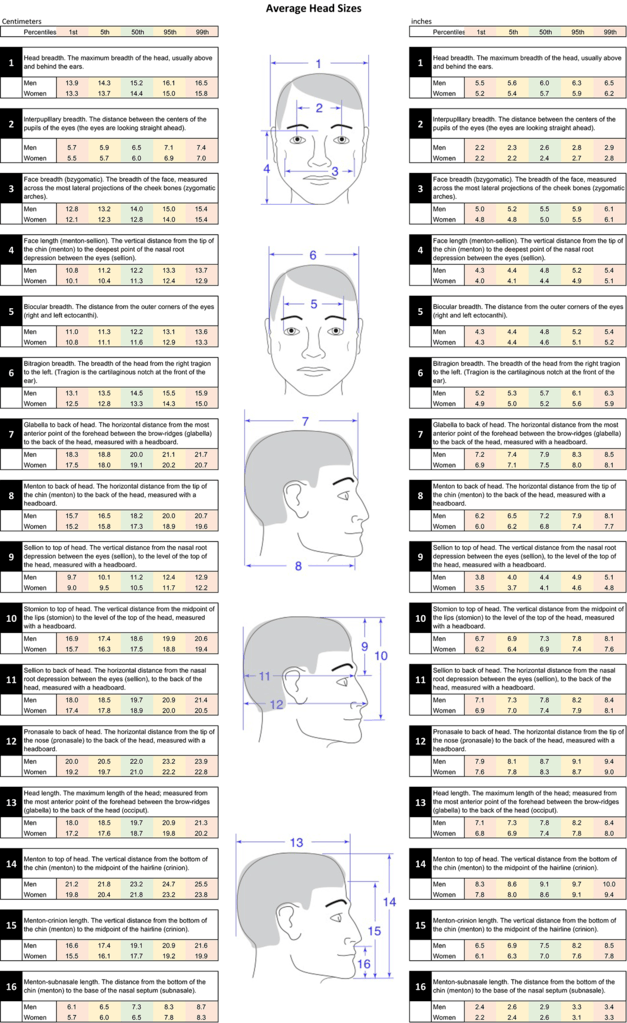
See also
References
- ↑ Brain Size and Intelligence
- ↑ Lakoff and Johnson 1980, 1999
- ↑ Nguyen, A.K.D (2012). "Head Circumference in Canadian Male Adults: Development of a Normalized Chart". International Journal of Morphology. 30 (4): 1474–1480. doi:10.4067/s0717-95022012000400033.
- ↑ TECHNICAL BRIEF - Relationship Between Head Mass and Circumference in Human Adults. Date: July 20, 2007. Principal Investigator: Randal P. Ching, Ph.D. Institution: University of Washington. Applied Biomechanics Laboratory.
- ↑ Bushby, KM; Cole, T; Matthews, JN; Goodship, JA (1992). "Centiles for adult head circumference" (PDF). Arch. Dis. Child. 67: 1286–7. doi:10.1136/adc.67.10.1286. PMC 1793909. PMID 1444530.
- ↑ Cowden Syndrome Detection Will Allow For Early Discovery of Cancerous Polyps. Date: December 7, 2010. Principal Investigator: Charis Eng, MD, PhD. Institution: Cleveland Clinic Genomic Medicine.
- ↑ Mester, J. L. (2011). "Analysis of prevalence and degree of macrocephaly in patients with germline PTEN mutations and of brain weight in Pten knock-in murine model". European Journal of Human Genetics. 19 (7): 763. doi:10.1038/ejhg.2011.20.
8. Human head
Further reading
| Wikimedia Commons has media related to Human heads. |
- Campbell, Bernard Grant. Human Evolution: An Introduction to Man's Adaptations, 4th edition ( ISBN 0-202-02042-8).